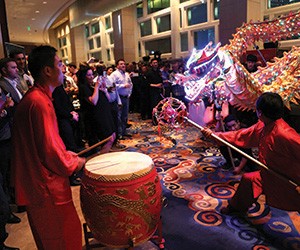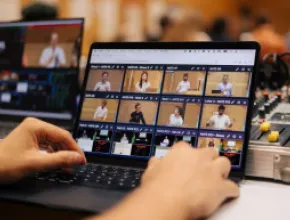While incentive programs are still dedicated to loyalty and team spirit, the Incentive Research Foundation (IRF) 2017 Trends Study noted the growing emphasis on individualized experiences designed to resonate on an emotional level with each attendee. In other key findings from the study, programs are once again heading to international destinations, and technology is creating exciting new ways to achieve goals.
Getting Personal
In noting the trend toward customized rewards, the IRF study said the focus for travel is no longer just on the venue and destination, but on “authentic, unique, individualized experiences delivered throughout the agenda. This had led to the productizing of mini experiences: from various types of tastings to personalized training sessions to behind-the-scenes introductions to chefs.”
The growing need to create memorable experiences for each incentive qualifier stems from what is happening in society at large, according to Melissa Van Dyke, president of IRF.
“Driving this is a greater focus on experiences in people’s personal lives,” she said. “As more and more people travel and create their own individually curated experiences—as Millennials often do, for example—the greater the pressure will be on meeting planners to create different, varied experiences that ‘wow’ participants.”
Intensifying the need for customized experiences is that three or even four different generations of people are often participating in the same event, leading to a diverse set of interests for planners to address, according to Van Dyke.
“As a result, planners are having a harder time finding the one thing that everyone will love,” she said.
Technology is another driver behind the increased need to provide experiences that resonate with attendees, Van Dyke added.
“The proliferation of sites and apps let people know at a moment’s notice what experiences are available within a destination,” she said. “Attendees can now relatively easily find an experience that meets their personal taste if they feel the event is not providing it.”
Delivering on personalization means that knowing the individual preferences of attendees is paramount, according to Van Dyke.
“Planners should make every effort to understand their audience in depth,” she said. “Not just what generation they are or what type of dinner they request, but what their favorite travel experience has been and what they like to do as hobbies or in their free time. If possible, instead of a single option for activities, offer four or five experiences on a first-come, first-served basis.”
Also mindful of the personalization trend, Nola Conway, president of Global Destinations Marketing, noted that the pressure is on for incentive planners such as herself to craft experiences that go beyond what attendees can provide for themselves.
“Today everyone has so many choices, which means we really have to turn things up a notch in order to stand out to the customer,” she said. “As planners, we have to make sure we are asking the right questions at the beginning of the RFP process so we can craft a customized proposal, site inspection, sales call—whatever it might be—to fit their specific needs. Attendees who are well traveled are constantly setting the bar higher for what is expected of their event or stay at a property.”
Planners are also under increased pressure to stay current or even get ahead of the curve, she added.
“With social media, news travels fast, so trends in the industry are talked about or posted everywhere we look,” Conway said. “It’s our job to stay on top of the newest trends or we will miss out on the business that requires a unique, personal touch.”
Among other incentive planners in sync with the personalization trend is Renee Radabaugh, president of Paragon Events, who said studying the group dynamics and creating engaging experiences to match individual needs is a major priority for her company.
“We’re finding that people are no longer satisfied with the ordinary and that they want to be participants rather than spectators,” she said. “They are looking for creative experiences and don’t want to just sit back and sip a drink with an umbrella in it anymore.”
Providing creative experiences means not just researching personal preferences but delving into the possibilities of each destination, she added.
“We don’t just look at the top 10 things to do, but go below the surface,” she said. “For example, if the program is in Cuba, it won’t be just going to a cigar factory. Instead, we’ll go to the tobacco plantation, meet with the planter and let people roll their own cigars. It’s taking the experience that people think they want and making it much larger than they thought possible.”
Finding a destination that allows for a choice of active or hands-on experiences is also important, she added.
“We look at destinations that can satisfy the thirst of the entire group,” she said. “Fortunately, a lot of destinations are stepping up their game by offering a wider choice of experiences that make things personal. Costa Rica is a great example of this—you can zipline, surf, take a cooking class or just lay by the pool.”
Global Yet Local
Another important trend addressed by the IRF study is the globalization of the incentive industry, including a growing interest in overseas destinations. According to the study, more than three-quarters of incentive travel program owners will run at least one program outside the U.S. this year. Equally important, however, is the need for international programs to connect with local culture, the study noted.
“The true challenge will not be globalization but localization,” the study said.
Radabaugh also sees this trend, observing increasing interest among clients in international destinations, despite the flight time involved. Her company has recently organized programs in Bali, Vietnam, China, Japan and Prague.
“Clients who once said they don’t want anything with a flight path of over six hours are now more flexible on this,” she said. “They know it takes more to dazzle people these days. Also, because the Internet has brought the world to us, there is a hunger for exotic experiences. The global destination has come back.”
No matter where the destination, the need to provide a connection to local people and culture is important, she added.
“People really want to be engaged in this way, whether it’s visiting an Indian reservation in Arizona or climbing the base of Mount Fuji, which is something the local Japanese do as a ritual,” she said.
The globalization trend means that forging stronger on-the-ground partnerships is more important than ever, according to Tahira Endean, a veteran meeting and incentive planner based in Vancouver, British Columbia.
“Being able to access unique experiences is best done with local experts guiding you,” she said. “Having been on both the DMC and planning side of the industry, I know how important it is to work with local professionals who understand the nuances of the destination. Budgeting and paying for this service will always net a more thorough and enjoyable experience for guests.”
Van Dyke agrees, adding that today’s politically unstable climate is also making on-the-ground partnerships invaluable.
“With the rise in disruptions in events as well as in the complexity of events, strong relationships with hotels and DMC partners become even more paramount,” she said. “This is especially true for incentives where many attendees are often VIPs.”
Tech Engagement
The IRF study also addressed the profound impact of technology on incentives, noting that the integration of mobile devices and social media into programs is now a standard expectation. The study urged planners to “evaluate their current technology portfolios to determine how they incorporate mobile, social, wearable, predictive and view-altering technologies to enhance the outcome of their programs.”
The study addressed the potential of new technologies such as wearables, noting how speakers can advance their presentations through gesture-controlled wearable armbands and how events can offer ways for participants to get points on their fitness trackers and health monitors. View-altering technologies such as virtual reality headsets, GoPro cameras and drones recording the event from above were also cited as potential enhancements.
While view-altering and wearable technologies are not yet a standard part of all incentive programs, Van Dyke said these and other new innovations are certain to become so in the near future.
“As these devices become more embedded in our day-to-day lifestyle, they will become an expectation in event delivery,” she said. “There was a time when having a mobile app for your program was seen as cutting edge, but for most programs it is now an expectation.”
Endean, a former marketing manager for the event app provider QuickMobile, has been at the forefront of using technology in the meetings realm, including arranging a gamification experience for incentive professionals attending an IRF event. She believes technology has great potential for fostering the networking and experiential elements so important to incentive programs.
“At the IRF event, we used gamification as a way for people to focus on the good time they were having,” she said. “We had them taking pictures and posting them throughout the event and getting points for what they did. It was a highly personalized way of using technology and increased the positive experience.”
She also sees innovations such as virtual reality and augmented reality as providing “amazing opportunities” to motivate qualifiers.
“Through VR and AR we can share the promise of the destination as a reward for potential recipients and their families as never before,” she said. “If you can actually see yourself under the 200-foot waterfall, isn’t that going to make you work harder?”







